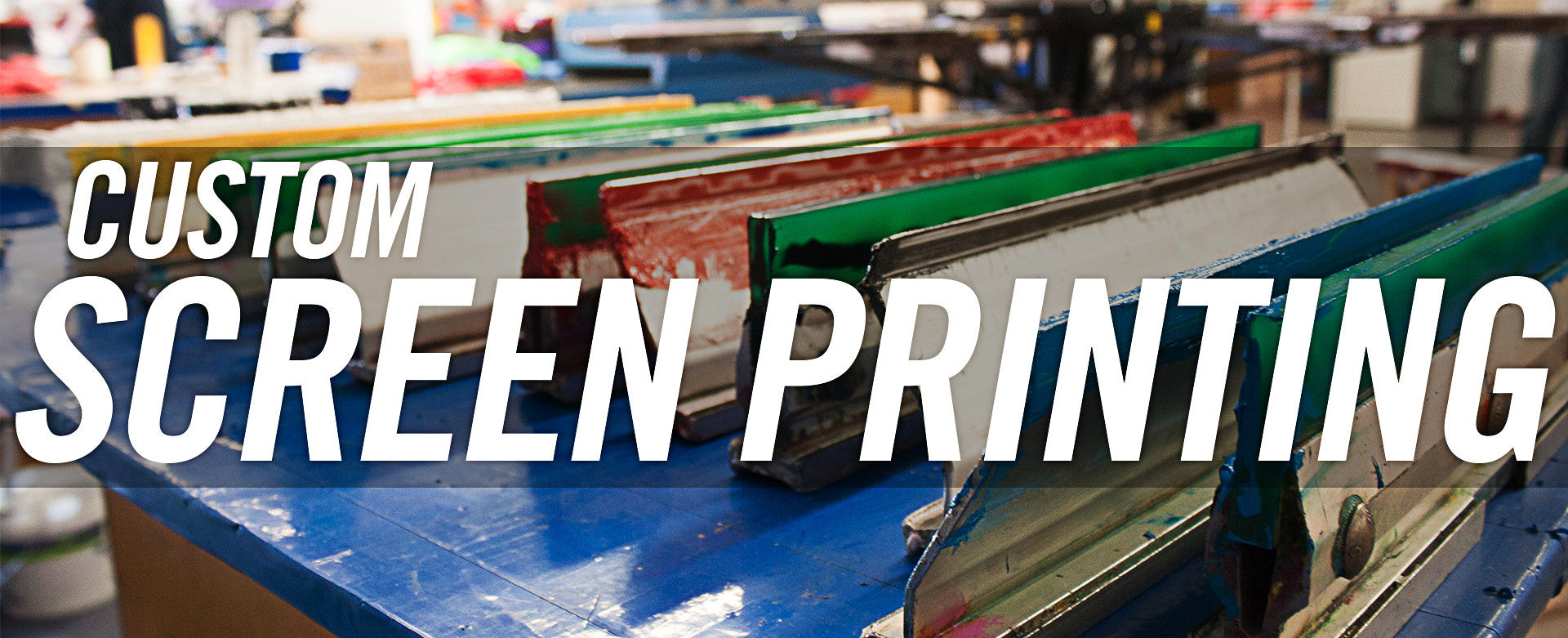High-Volume T-Shirt Printing for Schools and Organizations
Display Printing Uncovered: Every Little Thing You Need to Learn About T-Shirt and Garment Printing Techniques
If you have actually ever asked yourself just how those lively styles wind up on your favored t-shirts, you remain in the appropriate location. Screen printing is an interesting method that integrates art with method, offering unlimited possibilities for creative thinking. Comprehending the principles, from equipment to ink selections, can greatly affect your outcomes. Prepared to discover the crucial elements that make screen printing an art form? Let's uncover the details that can boost your projects.
The Fundamentals of Screen Printing: How It Functions
When you dive into screen printing, you'll discover it's both a scientific research and an art. At its core, screen printing entails developing a stencil, or screen, that permits ink to go through only in specific locations (screen printing kit). You begin by selecting your design and preparing your screen with a light-sensitive emulsion. Once you expose this emulsion to light, it hardens, leaving your style as an adverse room.
Following, you'll mix your inks and prepare your printing surface area. Placement the screen over the fabric, then use a squeegee to push ink via the display onto the garment. This process needs precision, as you want clear, dynamic prints. After printing, you'll cure the ink with heat, ensuring it abides by the fabric and lasts via washes. Each action is crucial, and understanding them will raise your display printing abilities, changing simple garments into one-of-a-kind, meaningful pieces.
Sorts Of Display Printing Strategies
As soon as you understand the fundamentals of display printing, it's time to check out the numerous methods that can elevate your layouts. One popular method is standard display printing, where ink is pushed via a stenciled display.
If you're going for great details, take into consideration discharge printing. This method removes color from the fabric, leaving a soft, vintage look. Another alternative is plastisol printing, known for its sturdiness and vivid shades, making it a favorite for lots of brand names. Experiment with halftone printing to create gradient effects and elaborate layouts. Each technique has its special beauty, so do not be reluctant to attempt them bent on find what matches your design best!
Necessary Tools for Display Printing
To attain stunning cause screen printing, having the right tools is basic. Initially, you'll require a durable display printing framework, which holds the mesh that moves your layout onto the garment. Next, purchase high-quality squeegees; these are essential for applying ink equally throughout the screen. You'll likewise require a good exposure system to produce your screens, along with a washout booth for cleaning them after usage. A dependable heat source, like a conveyor clothes dryer or warm press, is critical for curing your prints to ensure longevity. Do not fail to remember a correct work space, outfitted with tables and storage space for your materials. Protective equipment, such as handwear covers and masks, will certainly maintain you risk-free from chemicals and inks. With the right tools, you'll be well on your means to creating professional-quality prints.
Choosing the Right Inks and Products
When selecting inks and products for screen printing, you require to take into consideration the kind of ink that functions finest for your job. Think of textile compatibility to ensure your layouts look last and terrific lengthy. Likewise, discover eco-friendly ink choices to make your printing procedure much more sustainable.
Kinds of Screen Inks
Selecting the right display ink is vital for achieving lively, resilient prints that meet your task's requirements. There are a number of sorts of screen inks to take a look at. Plastisol ink is prominent for its flexibility and convenience of use, giving superb shade opacity on dark fabrics. Water-based ink, on the other hand, uses a softer feeling and is eco-friendly, making it excellent for those wanting to minimize their environmental impact. Release inks eliminate color from the textile, resulting in a soft, classic appearance yet need particular handling. Lastly, specialized inks, such as metallic or glow-in-the-dark, can add special results to your layouts. Examine your job demands and choose the ink that lines up finest with your desired result.

Fabric Compatibility Considerations
Understanding material compatibility is crucial for accomplishing top quality screen prints, especially given that various products respond distinctly to different inks. Always evaluate your inks on example material to guarantee they stick appropriately and preserve shade stability. Additionally, maintain in mind that fabric weight and appearance can affect the last outcome, so picking the appropriate ink and material combination is important for your project's success.
Eco-Friendly Ink Options
Eco-friendly inks are becoming a popular choice for screen printers that desire to minimize their environmental influence while maintaining top quality. When choosing inks, take into consideration water-based inks, which are less dangerous and less complicated to cleanse up compared to traditional solvents.
Additionally, try to find inks made from eco-friendly sources, such as soy or vegetable-based alternatives. By selecting the appropriate inks and materials, you'll not only develop stunning layouts however likewise contribute to a more sustainable printing procedure. Make the button, and your prints will certainly show your dedication to the setting!
Preparing Your Layout for Display Printing

Submit Format Needs
To assure your layout looks lively and sharp on textile, you'll need to pay very close attention to file layout demands for screen printing. Begin with vector files like AI or EPS, as they can be scaled without losing top quality. If you make use of raster pictures, choose high-resolution data, such as TIFF or PNG, ideally at 300 DPI. Avoid using JPEGs, as they can lose clarity when resized. Make certain your layout has a transparent history to prevent undesirable white sides on your prints. Keep color modes in mind; CMYK is basic for screen printing, so transform your RGB designs accordingly - screen printing kit. By adhering to these guidelines, you'll set your art work up for an effective print.
Color Separation Techniques
Color separation is a necessary action in preparing your design for screen printing, and mastering it can substantially enhance your print top quality. You'll need to break your design right into private colors, as each shade needs a different screen throughout printing. Start by recognizing all the colors in your style and create layers each. You can make use of software program like Adobe Photoshop or Illustrator to isolate and separate colors properly. Be particular to conserve each layer as a separate documents, commonly in a layout like TIFF or PSD. This precision not just guarantees precise color depiction however also streamlines the printing process. By taking notice of color splitting up, you'll accomplish vivid and professional lead to your screen-printed garments.
Resolution and Dimension
Attaining the best lead to screen printing begins with ensuring your style has the best resolution and size. Ideally, your artwork should be at the very least 300 DPI (dots per inch) for sharp, clear prints. Your final item could look less than professional and pixelated. if you utilize reduced resolution.
When it comes to size, consider the measurements of your print area. Design your artwork to match the last print size, preferably producing it in the real dimensions you'll be publishing. This way, you'll stay clear of any kind of unexpected scaling concerns.
Constantly examine your design in both vector and raster layouts. Vector graphics can be scaled without shedding high quality, making them perfect for screen printing. Preparing correctly will assure your style looks remarkable on every garment!
Step-by-Step Screen Printing Process
Display printing is a vibrant process that allows you to create lively layouts on various surfaces. To obtain started, you'll need a screen, emulsion, and your selected ink.
Put ink onto the display and utilize a squeegee to push the ink with the stencil onto the material. Raise the screen thoroughly and let the print completely dry. You've effectively display published your style.
Tips for Successful Screen Printing Projects
While you're diving right into your screen printing jobs, keep in mind that prep work is crucial to success. Beginning by collecting all your materials-- inks, displays, mops, and garments. A clean office helps stop undesirable mistakes, so clean up before you begin.
Next, verify your art work is high-resolution and effectively sized for your garment. Examine your screen for appropriate direct exposure and tidy it extensively to prevent smudges. When blending your inks, adhere to the maker's standards to attain the ideal consistency.
Throughout printing, use also stress with your squeegee for regular outcomes. Do not hurry; take your time to validate each print meets your requirements. After printing, allow your garments completely dry entirely before managing or packaging them.
Last but not least, always keep an example of your help future referral. By doing this, you can evaluate your progress and enhance your methods with time. Delighted printing!

Often Asked Inquiries
How much time Does It Require To Establish a Screen Printing Job?
Establishing a screen printing task generally takes around thirty minutes to an hour. You'll prepare the screens, mix inks, and adjust the press. The moment differs based on intricacy and experience, so remain arranged!
Can I Print on Different Fabric Types Using the Same Method?
Yes, you can publish on different fabric kinds using the same technique, however you'll require to readjust your inks and setups. Some fabrics absorb ink in a different way, so experimenting warranties the very best outcomes for each material.
What Are Common Errors to Avoid in Display Printing?
When display printing, stay clear of typical errors like utilizing the wrong ink, neglecting appropriate exposure times, or avoiding pre-press checks. Always evaluate your setup and preserve tidy displays to ensure top quality outcomes each time.
Exactly How Can I Appropriately Clean and Maintain My Display Printing Devices?
To effectively clean and maintain your display printing equipment, you ought to routinely clean displays with appropriate solvents, inspect mops for wear, and ensure all devices are saved dry and dust-free. Consistency stops costly repair services and improves efficiency.
Is Screen Printing Eco-friendly Compared to Various Other Methods?
Display printing can be a lot more eco-friendly than other techniques, especially if you make use of eco-conscious materials and water-based inks. By choosing sustainable products and methods, you reduce waste and reduce your effect on the world.
Display Printing Uncovered: Whatever You Need to Know About T-Shirt and Garment Printing Methods
At its core, display printing involves developing a stencil, or display, that allows ink to pass through just in certain locations. Placement the display over the fabric, silk screen printing then make use of a squeegee to press ink with the display onto the garment. One prominent method is typical display printing, where ink is pressed via a stenciled screen.When choosing inks and materials for screen printing, you require to take right into account the type of ink that works finest for your project.